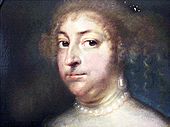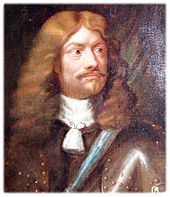Hannibal Sehested (politician, 1609)

Hannibal Sehested (* 1609 in Arensborg on Ösel , then part of Denmark , now Estonia , † September 23, 1666 in Paris , France ) was a Danish statesman.
Youth and family
Hannibal was the son of Claus Maltesen Sehested and Anne Nielsdatter Lykke. He attended the Sorø Akademi from 1626 to 1629 . After further studies abroad (including Germany), Hannibal entered the service of the Danish-Norwegian King Christian IV in 1632. In 1635, he conducted unsuccessful negotiations with Sweden in the king's name. Nevertheless, the king saw him as a promising young politician and engaged him in 1636 to his ten-year-old daughter Christiane (1626–1670) from their morganatic marriage with Kirsten Munk . In 1640 Hannibal became a member of the Imperial Council .
Governor of Norway
After his marriage, the king appointed him lieutenant (governor-general) of Norway in 1642. Although Hannibal had successfully fought at the head of Norwegian troops during the Danish-Swedish Torstensson War that broke out in 1643 (Hannibalfehde) , Norway had to cede the provinces of Jämtland and Härjedalen to Sweden in the Peace of Brömsebro in 1645 in view of the defeats of Danish troops . Hannibal's birthplace, the Danish island of Ösel in the Baltic Sea, also fell to Sweden.
After the war, Hannibal tried to alleviate the consequences of the war, to reorganize the country's finances, to modernize the administration and to increase the military strength. He not only created an independent Norwegian army and its own Norwegian financial administration, but gradually brought the entire administration and political power in Norway under his control. However, with Christian's death in 1648, Hannibal's star also fell. The Danish nobility in Norway suspected him of separatist tendencies and finally achieved Hannibal's deposition by Friedrich III in 1651 . Other sons-in-law of Kirsten Munk were also disempowered and fell out of favor. B. Corfitz Ulfeldt . Fearing for his life, Hannibal gave up his council post and fled abroad (including Germany, the Netherlands).
Imperial Treasurer of Denmark
When Hannibal wanted to return to Denmark in 1657 during another war with Sweden , he was taken over by Friedrich III. initially rejected. Hannibal then sought a conversation with the Swedish king Karl X. Gustav , who was currently besieging Copenhagen. From the Danish side, this was initially viewed as treason - especially since Hannibal's brother-in-law Corfitz Ulfeldt had defected to the Swedes and collaborated with them openly. But then in 1660 Hannibal was sent to the Swedes as a Danish peace negotiator and was instrumental in bringing about the peace of Copenhagen , which gave Denmark-Norway back Trondheim and Bornholm, which had been lost in 1658.
Since he was in the absolutist coup in 1660 on Frederick III. Had stood side, Hannibal again enjoyed royal favor in the Imperial Council and from then on worked as Chancellor of the Treasury (Imperial Treasurer) on measures to modernize the Danish administration as well. In Paris in 1663 he reached the conclusion of a treaty that brought Denmark French subsidies . From Friedrich III. he was made knight of the Elephant Order in 1648 , the French King Louis XIV made him count in 1663. Hannibal died on another diplomatic mission in France. His estates Iversnæs (today Wedellsborg ) and Tybrind (in Husby Sogn ) on the island of Funen inherited his daughter Christiane Sophie, who married Wilhelm Friedrich von Wedel (1640–93), who immigrated from Germany and who was raised to liege count Wedell-Wedellsborg in 1672.
literature
- Britannica.com : Hannibal Sehested
- Ralph Tuchtenhagen : Brief history of Norway , page 74. CH Beck, Munich 2009
- Johann Heinrich Friedrich Berlien: The Elephant Order and its knights , page 66.Berlingsche Officin, Berlin 1846
- Friedrich Ferdinand Carlson: History of Sweden , Volume 4 (Up to the Reichstag 1680), Pages 374f and 478. Perthes, Gotha 1855
| personal data | |
|---|---|
| SURNAME | Sehested, Hannibal |
| ALTERNATIVE NAMES | Sehestedt, Hanibal |
| BRIEF DESCRIPTION | Danish statesman and Reichsrat |
| DATE OF BIRTH | 1609 |
| PLACE OF BIRTH | Arensborg on Ösel |
| DATE OF DEATH | September 23, 1666 |
| Place of death | Paris , France |
